 This is an Argus C4, a 35mm rangefinder camera produced by Argus in Ann Arbor, Michigan. This particular example has what’s called the Geiss modification offered by Argus from 1954 to 1956, which for $10 they would send the camera to a Chicago company called Geiss where it’s lens would be removed and modified with a unique interchangeable lens mount. The original 50mm f/2.8 lens would be replaced using this mount, and a selection of four more lenses all made by Enna Werke of München, Germany could then be mounted onto the camera. This gave the C4 Geiss a unique combination of being an inexpensive, but solidly built American camera with the benefit of highly respected German lenses.
This is an Argus C4, a 35mm rangefinder camera produced by Argus in Ann Arbor, Michigan. This particular example has what’s called the Geiss modification offered by Argus from 1954 to 1956, which for $10 they would send the camera to a Chicago company called Geiss where it’s lens would be removed and modified with a unique interchangeable lens mount. The original 50mm f/2.8 lens would be replaced using this mount, and a selection of four more lenses all made by Enna Werke of München, Germany could then be mounted onto the camera. This gave the C4 Geiss a unique combination of being an inexpensive, but solidly built American camera with the benefit of highly respected German lenses.
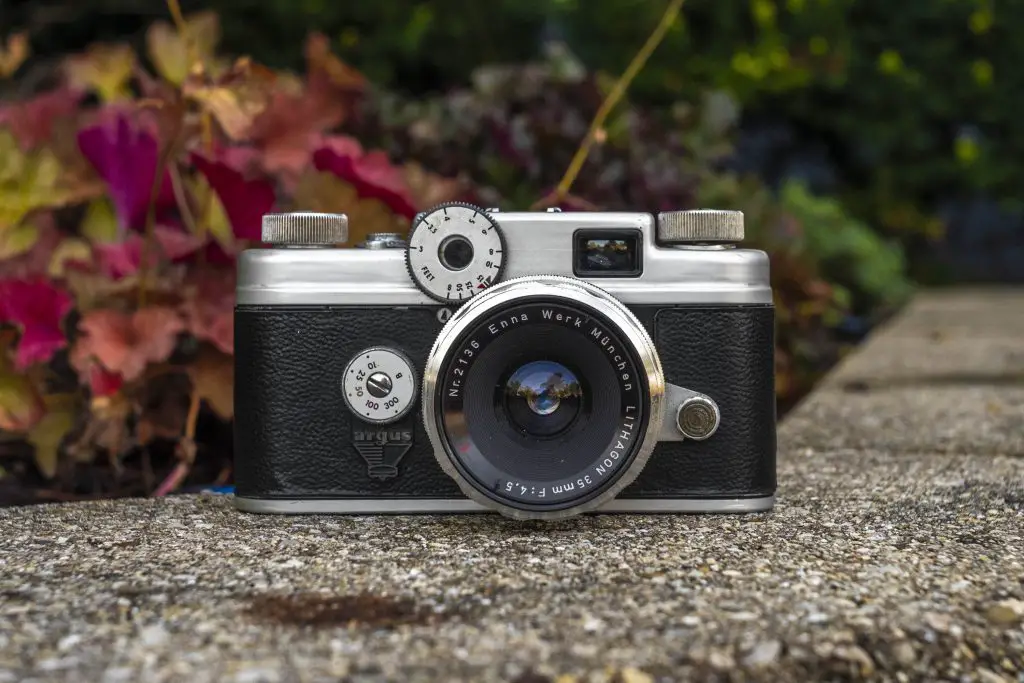 Film Type: 135 (35mm)
Film Type: 135 (35mm)
Lens: 35mm f/4.5 Enna Werk München coated 4-elements in 3-groups
Lens Mount: Argus Geiss Breech Lock
Focus: 3 feet to Infinity
Viewfinder: Coincident Image Coupled Rangefinder
Shutter: Behind the Lens Leaf
Speeds: B, 1/10 – 1/300 seconds
Exposure Meter: None
Battery: None
Flash Mount: Hot shoe, MX Flash Sync at all speeds
Weight: 686 grams (w/ Cintar 50/2.8), 799 grams (w/ Lithagon 35/4.5 and Argus VF), 508 grams (body only)
Manual: https://www.cameramanuals.org/argus/argus_c4.pdf (camera only)
Manual: https://www.cameramanuals.org/argus/argus_c-4_lithagon_lenses.pdf (Lithagon lenses)
How these ratings work |
The Geiss modified Argus C4 adds an interchangeable lens mount to the otherwise same Argus C4, allowing the use of a variety of wide angle and telephoto lenses to be used. The Geiss mount was easier to change than both the original C3 or later C44’s mount, but was not without problems as it loosens up over time causing nearly every example to wobble. The C4 itself has a number of improvements over the C4, and with the ability to shoot different focal lengths, some people consider this to be the best interchangeable lens American camera ever made. I don’t know if I agree with that, but it’s certainly an interesting camera, and one worth considering, especially if you can find one with it’s lenses. | ||||||
| Images | Handling | Features | Viewfinder | Feel & Beauty | History | Age | |
| 2 | 1 | 1 | 2 | 1 | 1 | 30% | |
| Bonus | none | ||||||
| Final Score | 10.4 | ||||||
History
With the release of the Argus C-series in the late 1930s, Argus became the largest camera company in the United States. After World War II when Argus resumed production of the C3, it was the best selling camera in the United States. Profits for Argus soared between 1949 to 1954 from $6 million to $22 million, but by 1950, the company realized it couldn’t make the C3 forever and began working on it’s replacement.
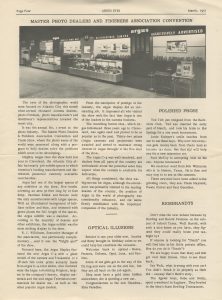
The camera that would be called the C4 made it’s debut in March 1951 at the Master Photo Dealers and Finishers Association Conversion in Atlantic City and featured an all new body with curved corners offering significantly improved ergonomics over the brick-like C3. It had a modern and much larger combined coincident image rangefinder, allowing for focus and composition within the same window. Another big change was the inclusion of a flash hot shoe on the top plate of the camera allowing for easy connection of a flashgun on top, rather than the side of the camera. A switch on the back allowed the selection of both M and X flash sync, something not possible on the C3. In a nod to the design of the earlier C3, the C4 retained the front mounted rangefinder coupling wheel which allowed the user to focus the camera with his or her right fingertip while holding the camera to the eye.
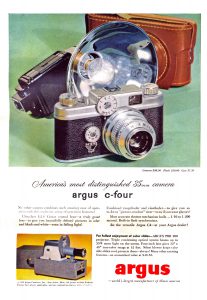
The C4 was a significantly improved camera from it’s predecessor, but it lacked one major feature which was the interchangeable lens mount. In it’s place was a fixed 50mm f/2.8 Cintar Anastigmat lens. Argus likely justified this as the majority of C3 users never changed their lenses, and by only offering the 50mm Cintar, it could sell the C4 at a lower cost.
When it first went on sale, the C4 sold for $99.50, only $30 more than the C3 which considering it’s many improvements, helped make it more competitive compared to much more expensive imported models.
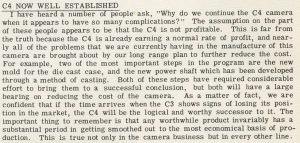
It is not clear how successful the C4 was, at least compared to other Argus camera models. In many issues of Argus’s company newsletter, Argus Eyes, reports of demand exceeding production for the C4 were common, but also the short blurb to the right from November 1952 suggests that the camera went through some early growing pains, suggesting some production issues which may have affected sales.
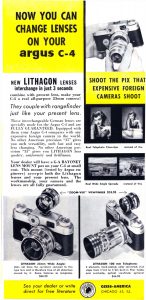
Although the camera offered several compelling improvements over the C3, the earlier camera remained the company’s best selling model. Perhaps in an effort to address the one missing feature of the C4, in 1954, Argus would arrange for a factory supported third party modification by Geiss America of Chicago to add an interchangeable lens mount to the C4.
For only ten dollars, new and existing owners of the Argus C4 could have both their camera and original Cintar 50mm f/2.8 modified with the new Geiss mount. The camera would still be fully guaranteed by Argus, not affecting it’s warranty. In my research for this article, the only reference to having this modification says to talk to your dealer, but it is not clear where the exactly the modification happened. Was it done by Geiss America in Chicago, or Argus in Ann Arbor? Looking at the examples I have, the modification seems to be a bit too complicated to be done by a camera dealer.

With the modification, the camera worked exactly as before, with the most obvious cosmetic difference being a new lens release lever near the 3 o’clock position around the lens. But now, they had access to up to four additional Lithagon lenses all made in Germany by Enna Werk München. The complete list of available lenses and their original prices are:
- 35mm f/4.5 Lithagon – $57.50
- 45mm f/1.9 Lithagon – $99.50
- 100mm f/4.5 Tele-Lithagon – $59.50
- 135mm f/3.5 Tele-Lithagon – $99.50
Originally, only the 35mm f/4.5 and 100mm f/4.5 Lithagons were available, with the 45mm f/1.9 and 135mm f/3.5 added later. Also, a few sites online incorrectly state that a 35mm f/3.5 Lithagon and a 135mm f/2.8 Tele-Lithagon existed, but I believe this is incorrect as there is no evidence to support lenses with those specs were ever made.
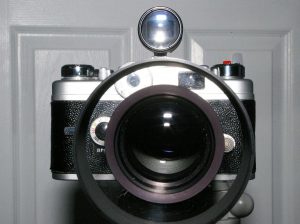
Of all the lenses, the 45mm f/1.9 is the most valuable today, but perhaps the most interesting is the 135mm f/3.5 Tele-Lithagon, or more specifically, the included lens hood that came with that lens. With an outer diameter of 54mm, the 135mm Tele-Lithagon needed a larger hood, but making the hood any larger would block the view through the camera’s main viewfinder. When faced with this problem, most lens makers would create a hood with see through metal fins that hold the hood away from the main part of the lens, while allowing the photographer to see through the openings. For this lens however, Enna Werk chose a design which suspended the hood with a circular piece of glass, allowing the photographer to see through the 81mm hood without any obstruction.
In addition to any concerns of how fragile it might be, the large piece of glass likely added quite a bit of weight to the hood, along with the extra heft from a long telephoto lens, likely making the whole package quite heavy. If you can find a 135mm lens for the C4 Geiss, make sure it still has the original hood before paying any significant amount of money for it.
There is no information about how many modified or non-modified C4s are out there. Enna Werk produced similar Lithagons in a variety of other mounts too, so finding them with the Geiss mount can be tricky today, so the only estimate I can give as to how common these cameras are today, is “not much”. Whatever the real number is, it must have been enough for Argus to eventually design a camera with it’s own interchangeable mount as in 1956, the Argus C44 would make it’s debut. The C44 was pretty much identical to the C4 Geiss, except instead of the Geiss mount, it used an Argus designed lens mount that was completely incompatible with Geiss lenses. The C44’s lenses were also built in Germany, but this time by Steinheil München.
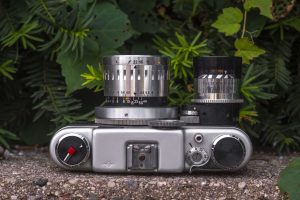
In 1958, an improved model called the C44R was released which replaced both the advance and rewind knobs with a film advance lever and rewind knob with fold out handle, as was common on many 35mm cameras by that time. It also added support for an optional coupled selenium exposure meter. Despite these improvements, sales of all Argus cameras had hit a wall, Argus’s once promising German division had been shut down, and an ownership change the previous year to Sylvania Electronics meant that the direction of the company was shifting.
Interestingly, after Argus released the C44, Geiss continued to offer the conversion on unmodified C4s and even offered them on the short lived C4R which received all the upgrades of the C44R, but without an interchangeable mount.
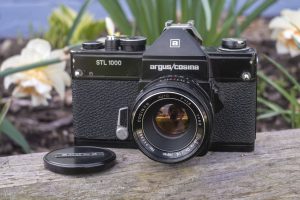
Argus would discontinue the C44R in 1962 and the C3 in 1966 ending their run as America’s leading camera maker of the 20th century.
Argus branded cameras continued to be sold after 1966, but they were all rebadged models from other companies like Petri and Cosina. By the mid 1970s, all that remained of the original Argus company was gone with the name lingering on as an intellectual property over the next several decades. If you look hard enough (I don’t recommend it), you can even find some cheap Chinese made digital cameras branded with the Argus name today, but like what has happened with other once powerful camera marques, they are not at all related.
Today, there is a small, but loyal group of Argus collectors who appreciate the company’s later offerings like the C4, C44, and C44R. While not absurdly rare, the C4 Geiss is one of the harder Argus cameras to find, and with it’s selection of lenses, is highly desirable by those who like these cameras. As a user, when found in good condition, these are some of the nicest to use Arguses ever made.
My Thoughts
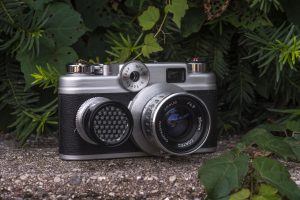
In my August 2019 review of the Argus C44R, I admired the improvements that camera had over the Argus C3 saying that with a larger viewfinder with combined coincident image rangefinder, film advance lever, improved ergonomics, and a selection of German designed lenses, I felt I would like the camera more, instead I came away underwhelmed. I found that camera to feel stiff, and despite having so many improvements on paper, it did not add up to a camera that was more enjoyable to use than the venerable Brick.
Above all, I hated the lens mount. I found it’s operation to be unintuitive and unnecessarily complicated. I quoted Stephen Gandy in his review for the camera who humorously suggested the mount was designed by aliens to test the patience of humans and while Stephen’s comments might have been a little exaggerated, I definitely agreed that the lens mount was terrible.
So when I later found out that an earlier version of the non-interchangeable lens C4 at one time came with a factory supported aftermarket modification that gave it a much easier to use interchangeable mount, I was intrigued.
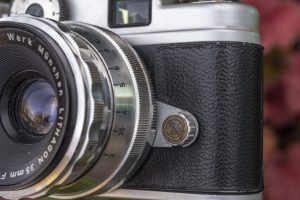
Finding a C4 with the Geiss modification was a bit of a challenge however. For starters, not many were made so therefore there aren’t many for sale today. Complicating matters worse is that apart from the interchangeable mount, there are no other cosmetic differences between a C4 Geiss and a regular C4. The word “Geiss” does not appear anywhere on the camera, and although Argus collectors will know one when they see one, to the average eBay seller who “doesn’t know much about cameras” it is unlikely they’d be correctly identified in any listings for one.
My plan for locating one was to simply search for regular Argus C4s and look for one that that slipped through the cracks. Identifying a C4 Geiss is quite simple as they will have the round lens release lever near the 3 o’clock position around the lens, which regular C4s don’t.
It would take me two years to find one in acceptable condition, at a price I was willing to pay, and came with at least one of the other lenses. Eventually, I would have my C4 Geiss.

The C4 Geiss is an earlier design than the C44R I previously reviewed, so it lacks the film advance lever and rewind knob with flip out handle. Instead you have two knobs that each perform their respective functions. While it’s generally assumed that levers are better than knobs, the ones found here work good enough to where the lack of a lever isn’t much of a problem. In fact, on this camera, I found the film advance knob to be easier to turn and less stiff than the lever on the C44R. I am unsure if that’s due to stiffness in my example, or if the earlier cameras were just smoother.
Like the later camera, there’s a flash hot shoe, subtractive exposure counter, and cable threaded shutter release button. The exposure counter shows how many exposures remain on the roll down to ‘zero’ and must be reset after loading in each new roll of film.

The bottom of the camera featured the same film door release lock and 1/4″ tripod socket as the non-Geiss C4. There is no button or lever needed to rewind film at the end of the camera as this is accomplished by pulling up on the film advance knob and giving it a slight backwards turn to deactivate the film transport while rewinding.

There’s not much to see on the back of the camera other than the rectangular eyepiece for the viewfinder and the M/X flash sync switch. Earlier C4s will have an M/F switch, instead of M/X. The leaf shutter on the C4 is fully synchronized at all speeds from 1/10 to 1/300. Despite what looks like a regular flash hot shoe, the C4 requires an Argus specific flash gun and will not work with modern electronic flashes, so do not try to mount one.
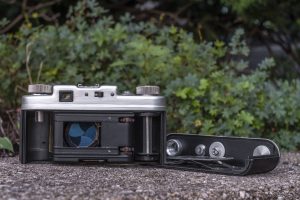
Releasing the film door lock on the bottom of the camera removes the entire back and bottom of the camera, revealing an ordinary looking 35mm film compartment. Film transports from left to right onto a fixed take up spool. The spool itself does not have a normal slot, rather has one flat side with a metal bar extending across it’s length in which you insert the film leader between the metal bar and the plastic spool, allowing the tension of the bar to hold the leader in place. With a few rotations of the film advance knob, the film wraps around itself, held in position by the metal bar. It’s an effective, although inelegant solution, which makes loading film very easy.
Inside of the film door is an unpainted metal film pressure plate with a ribbed texture which helps to reduce friction as film passes over it. As is the case of other cameras from this era, the Argus C4 has deep door channels with a fabric based light seal running along the top seam. There are no foam seals which need to be replaced and I had no problems with light leaks in either this, or the C44R which is setup the same way.
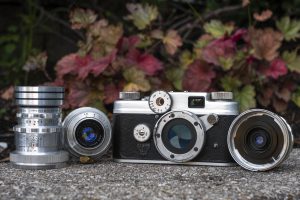
With the lens mount being the signature feature of the Argus C4 Geiss, I can report that it’s a bit of a mixed bag. Comparing this mount to the one Argus designed for the C44R (and the earlier C44), I can immediately say that it is a much simpler design allowing lenses to be detached and reattached easily.
Where the C44R requires four red dots to be aligned and a careful process of ensuring the lens is correctly set to infinity while pressing inward on a small tab near the bottom of the lens while rotating, the C4 Geiss only requires you to line up the focusing scale to infinity and raise the lens release lever normally located at the 3 o’clock position around the lens. Once you raise the lever, the lens will literally fall off the camera so make sure you are supporting the lens or else risk it falling to the floor.
Putting the lens back on is easy too. Even though it must be correctly set to infinity, this is much easier to accomplish as you can keep rotating the lens until you feel it catch at the infinity position. There is no need to line up red dots.
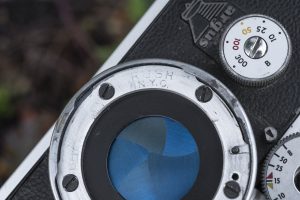
Where the lens mount on the C4 Geiss fails is in it’s quality. This is clearly an aftermarket solution, modified on a camera that wasn’t designed to change lenses to begin with. The bayonets that hold the lens to the camera are very narrow, and on my example lack sufficient strength to keep the lens securely attached to the body. Upon surveying other C4 Geiss owners, it seems all of these cameras have a noticeable wobble present on all lenses attached to the camera.
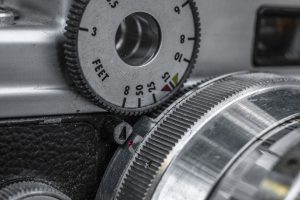
Looking at the geared teeth that mesh with the rangefinder focus wheel, the lens looks barely attached to the camera. When I first received the camera, I initially thought something was wrong with it as the lens seems to be pushed away from the body about an 1/8th of an inch, but no amount of pressure allows you to get it to sit closer to the body.
When owners sent in their regular C4s to receive the Geiss modification, the original Cintar lens was modified also and then reattached to the camera. The owner would still need to buy either of the Enna Werk wide angle or telephoto lenses. I have all three, and surprisingly, the original Cintar seems to be the one that feels the most secure on the camera, suggesting that the Enna Werk lenses likely were possibly adapted from some other type of lens mount and not purposely built for Argus.
It all works, and I didn’t have any issues with the lens falling off, but it’s hardly confidence inspiring to feel the lens constantly wobbling around on the camera while out shooting with it.

As is the case with most of Argus’s rangefinder cameras, shutter speeds are changed via a metal dial on the front face of the camera. Speeds from 1/10 to 1/300 plus Bulb are chosen with very positive click stops. The camera’s user manual warns against trying to shoot in between speeds saying the dial must be properly set at each interval.
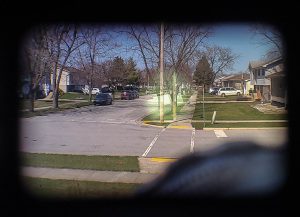
The viewfinder is by far the best improvement of the C4 over the C3. My example was extremely clear, without any haze and with an accurate rangefinder. The main part of the viewfinder has a pinkish/purple tint to it with the large circular rangefinder having a slight yellow tint, giving both excellent contrast. There are no projected frame lines, and the main viewfinder only shows a 50mm image, so when using either of the Enna Werk lenses, an auxiliary viewfinder is necessary, but for 50mm images, the viewfinder is excellent. My only complaint is the close location of the viewfinder window to the lens mount which causes the lens to be visible in the lower right corner. In the previous image to the left, I have the 35mm wide angle lens which is a bit wider than the 50mm Cintar, so for that lens, it would be less noticeable, although it is still there.
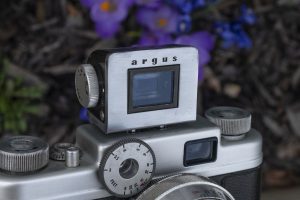
Although it’s not part of the camera, the clip-on Argus Variable Power Viewfinder not only looked great on the camera, it works really well too. Unlike cheaper viewfinders that were made for the C3 that simply use a metal frame to mask off the telephoto focal length, this finder uses a rotating prism that allows you to choose correctly magnified 35mm, 50mm, and 100mm lenses. It even has a parallax correction knob that raises and lowers the finder. This viewfinder was made specifically for the later C44, but I found that it works fine on the C4 Geiss.
The camera isn’t a complete disaster though, as it has good ergonomics, an excellent viewfinder, and and optional German lenses known for good performance, so what is it like to shoot? Do the German Enna Werk lenses make up for it’s shortcomings?
My Results
I tested the C4 Geiss a couple of times with different film stocks both of which were partial rolls used in other cameras. With the original 50mm Cintar, I used fresh Kodak ProImage 100, and with both the wide angle and telephoto lenses, I used expired Kodak 100 Gold. The images on the Kodak 100 Gold have a washed out look due to the film. I was unhappy with nearly all of these original images, so I shot the camera one more time with some fresh Kodak Tmax 100.











My first two rolls of film through the Argus C4 Geiss were wrought with problems. For starters, the images shot on the Kodak Gold 100 all had a horrible tint to it that I had not see on other examples of that same film. Expired color film is not known for accurate colors, but I’ve generally been pleased with the results from this same film, but with the Argus, it produced images with a heavy blue tint that I was not able to satisfactorily remove in post processing. The second problem was that the 100mm telephoto lens had some internal haze that I had initially noticed, but didn’t think it looked that bad. As it turned out, all of the telephoto shots look extremely hazy and without much contrast.
Realizing that I wasn’t doing the camera any justice with my first two rolls, I wanted to give the Argus one more try with a roll of film I knew would turn out good. It would take me a few months to get around to it, but when the time finally came to load in some Rollei RPX 25, I hoped third time would be the charm.
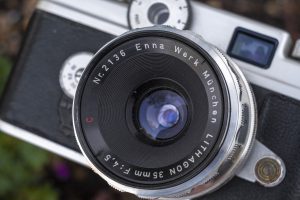
As I had hoped, the Argus loved the Rollei film and I got an entire roll of sharp images corner to corner. Most of the roll was shot with the Cintar 50mm f/2.8 lens, but a couple used the wide angle Lithagon. Looking past the poor results from the first two rolls and including the third, I feel as though I can still judge the quality of the C4 and it’s lenses to be quite good, easily as good as the Sandmar and Cintar lenses for the C3.
Interchangeable lenses aside, the C4 is a significant upgrade to the C3. I appreciated it’s more modern and rounded ergonomics. The curved edges and satin chrome top and bottom covers are very nice, giving the C4 a refined, almost European look. I am uncertain of what the black body covering is made of, but in two different C4s and C44R in my collection, none show any signs of peeling, suggesting that whatever it is made of is durable.
The viewfinder is by far, the camera’s biggest upgrade over the C3. Geiss modified C4s didn’t exist prior to 1954, but when you consider the original 1951 C4 has the same viewfinder and compared to other 1951 35mm rangefinders, the one found here is larger and brighter than those on most other cameras at the time. With lenses other than 50mm, the camera’s viewfinder can only be used for focus, so you need to use some other auxiliary viewfinder, but considering that’s how Leica and Nikon rangefinders were, you can’t really call that a con.

The selection of shutter speeds from 1/10 to 1/300 isn’t as impressive as other German or Japanese shutters, but this range of speeds covers what likely greater than 99% of photographers would have used, not to mention, any attempt at making a more advanced shutter would have dramatically increased the cost of the camera. As an aside, I quite liked the sound of the Argus’s shutter firing, as it makes a reassuring ssssssnICK sound each time it fires.
Overall, the C4 is a fine camera with a competitive feature set, especially for the price it sold at. Argus was right in 1951 to release an update to the C3. Many of the C4’s improvements made it a much better camera than it’s predecessor. I can defend the decision to not include an interchangeable lens mount as it’s probably true that a huge number of C3 users had no desire to change lenses so a fixed lens rangefinder definitely made sense for many customers.
However, in looking at the C4 Geiss and the later C44 and C44R, it seems Argus quickly changed their position on interchangeable lenses. It seems to me like it would have made more sense to have both a fixed and interchangeable lens version of the camera available from the very beginning. The fixed lens C4 could have been offered as the economic solution, with the interchangeable lens C44 as a $10 upgrade for those who wanted German quality optics at an American camera price.
Instead, they waited three years before settling on the aftermarket Geiss modification, which suggests that Argus was simply “testing the waters” and had not yet decided on an in-house solution. When they finally did release the C44 in 1956, they didn’t continue with the Geiss mount and instead came up with yet another mount, rendering all previous lenses incompatible. This likely confused consumers as you could have a C4 Geiss with one type of German lens, and an otherwise identical C44 with a completely unrelated type of German lens. If I was a photographic dealer around this time, I would have wondered what they were thinking.
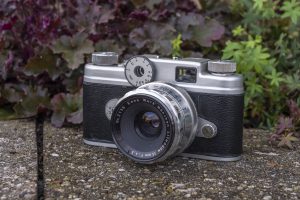
In regards to the mount itself, although the Geiss mount was easy to change, it was clearly an aftermarket solution as it doesn’t couple with the body very well. When Argus finally did make their own mount 5 years after the C4’s release, they gave the C44 perhaps one of the worst lens mounts found on any camera, ever. I’d even argue the C44’s mount is worse than the C3’s as the C3 is just a simple screw mount with an inelegant rangefinder coupling. The C44’s mount is overly complicated and requires two different pairs of red dots to line up. Why Argus couldn’t have just gone with a completely normal bayonet mount is a question I wish I knew the answer to.
Argus could have avoided all of this, if in 1951 the C4 and C44 were both released simultaneously with the C44 having a simple bayonet and used the rest of the decade to build up a selection of lenses which would have positioned the Argus C4 and C44 as an economical competitor to the massively growing number of Japanese rangefinder alternatives.
In the end, we have a total of 3 different models, all sharing a similar body design, rangefinder, viewfinder, and shutter, two different lens mounts, that ended up being outlived by the original camera it was designed to replace. Of course, none of that makes the C4 or the C4 Geiss bad cameras, in fact, I quite liked them both. I don’t know if I would go as far as to say it’s the best interchangeable lens American camera ever made as my pick for that would be the Kodak Ektra, but the Ektra was an extremely rare and insanely expensive camera, whereas the C4 Geiss was at least within the price range of the average person, so I guess for that, I’ll declare it to be “the best interchangeable lens American camera that most people could afford”.
Related Posts You Might Enjoy
External Links
http://camera-wiki.org/wiki/Argus_C4
http://camera-wiki.org/wiki/Argus_C4_Geiss
https://www.cameraquest.com/arggeiss.htm
https://www.rangefinderforum.com/forums/showthread.php?t=37261

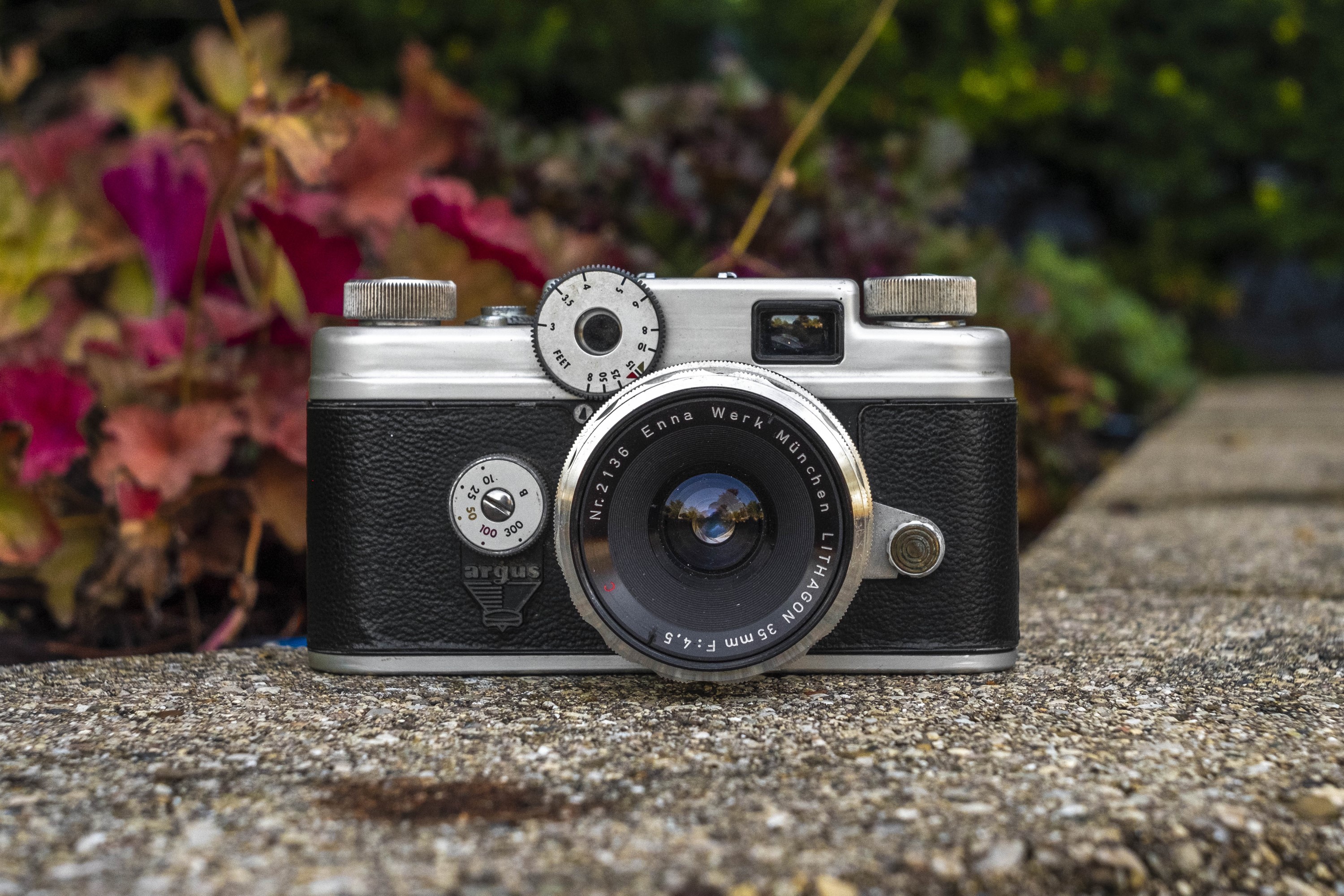
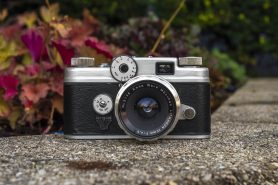











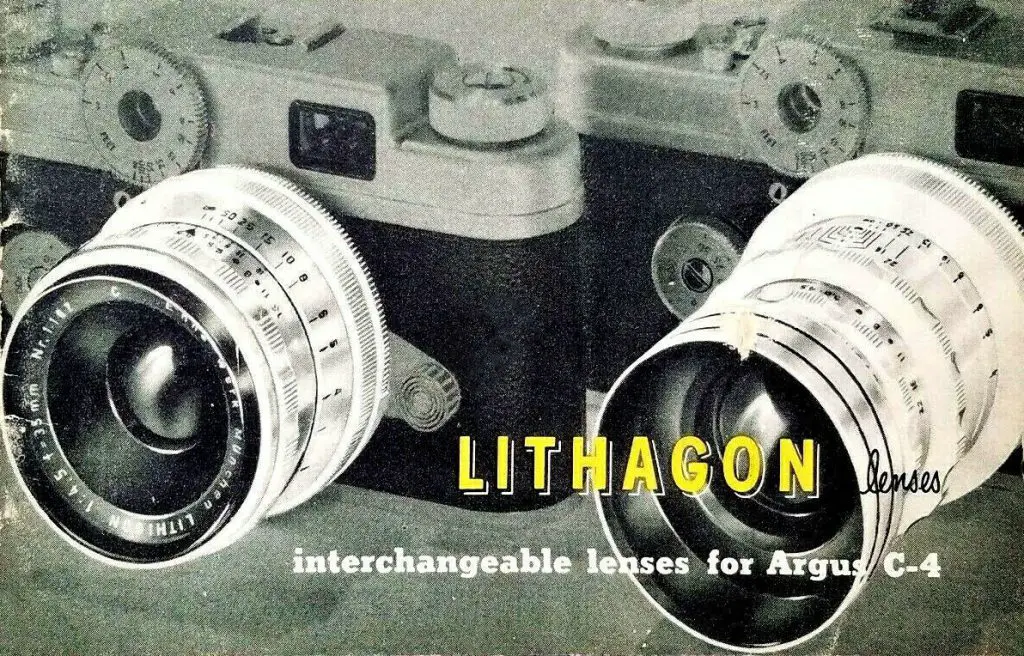
Mike, here’s another article on a camera that’s rarely seen these days. Ten years ago I bought one of these on That Auction Site for the price of a regular C4 (seller did not know what they had, but their photos revealed the modded lens mount.) I second your comments about the wobbly lens mount – the arrangement felt homemade in use. Changing lenses was a challenge.
Finding these listed as regular C4s is how I found mine as well. When people know what they are, they typically ask way too much for them, but when they don’t you can still get them today for a bargain!
It is probable that although the Geiss conversion was promoted by Argus the actual work was done by Geiss. After Argus produced its own interchangeable lens camera (C44) Geiss continued to advertise its lenses and conversion (free if you purchased one their lenses).
In the middle of the 1958 18 months after they had ended the production of the C4 they produced the C4r. This was identical to the C44r except that it did not have interchangeable lenses. Only 6,000 were produced and an unknown number of them received the Geiss Conversion.
This is great info Peter! I guess it would make sense for Geiss to continue to offer the conversion on cameras already purchased, because it’s not like Argus could prevent someone from sending in their camera to get upgraded. I still think Geiss’s solution, even though it was wobbly, was better than what Argus came up with.
Mike, I had so many Argus cameras pass through my hands over the years that I lived in Ann Arbor, that I feel that i know all of the cameras pretty well – except for the Geiss-modified C4. Nice review, and I think the C4 was the apex of the Argus offerings. It has a decent style to it, is reliable, and is fairly easy to shoot with. If you don’t have a copy, try to find Argomania by Henry Gambino. The Argus Museum in Ann Arbor may still have some.
Cheers,
Mark
Thanks for the feedback, Mark! The C4 and C44 were both terrific cameras, hinting that Argus could have been on the verge of something great, but sadly, mismanagement and a lack of a clear direction for their cameras doomed the company. I think that had they made better decisions upon the release of the C4 in 1951, that the company could have survived much longer.
The lenses wobble when the flanges on the lens mount are bent, It’s easy to see if you take off the lens and look straight across the mount. The long, thin slots should be straight. If they are spread apart the lens will be loose. It is not difficult to press the flanges a little tighter. You don’t even have to take the mount off the camera. The link is to a picture of a mount without a wobble. https://flic.kr/p/2mb6dZX Unfortunately I did not take a “before” picture.
This is great info, William! I did notice those flanges are bowed out on mine. I’ll have to try bending them back in to see if that helps. I have to imagine that this is something all owners of this camera should check, as it seems pretty common.